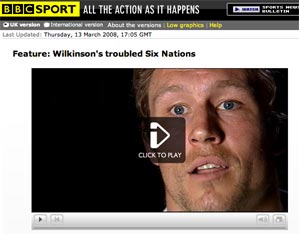Tips include: ‘Write the spoken word, not the literary one’ when scripting voiceovers; and ‘Video agencies sell pictures, so should you.’
Tag Archives: Digital video
Wired: Flickr groups reject new video feature
Several user groups on Flickr have been set up against the introduction of video to the image-sharing website, which was announced earlier this week.
Users are concerned that there was no pilot stage for the service, which allows ‘Pro’ subscribers to submit 90-second video clips alongside images.
By Thursday the ‘We Say No to Videos on Flickr’ group had more than 22,000 members.
Social Media Journalist: ‘Services like ustream or qik that live stream video from DV cams and phones have huge potential’ Damon Kiesow
Journalism.co.uk talks to reporters across the globe working at the collision of journalism and social media about how they see it changing their industry. This week, Damon Kiesow, Nashua Telegraph.
1. Who are you and what do you do?
I am the Managing Editor/Online at The Telegraph in Nashua, NH. I am responsible for the overall news presentation and strategy for our digital publications including NashuaTelegraph.com, NHPrimary.com, FeastNH.com and EncoreBuzz.com.
We have a staff of about 50 in the newsroom and nashuatelegraph.com was a finalist in two categories in this year’s Newspaper Association of America Digital Edge Awards.
2. Which web or mobile-based social media tools do you use on a daily basis and why?
On a typical day:
I use each for a variety of reasons. Delicious is my reigning favourite due to the huge filtering and early warning effect it provides. I follow about 78 people, mostly digital media professionals.
A few times per day I review their most recent bookmarks to keep up to date on what they are thinking about and what new tools and toys they have discovered.
I know many of them do the same and some of my ‘best’ ideas we have implemented at the paper have come from those bookmarks.
Twitter serves a similar purpose – and I am following many of the same people as on Delicious. But I like Twitter for the flexibility (IM, phone, PC, Web) and both the immediacy and asynchronous nature of the service.
It is just a great way to stay in touch with people without the burden of reading or responding to email or phone calls.
I use Ning mostly every day to visit sites like wiredjournalists.com, and we have created several Ning sites for the newspaper including Encorebuzz.ning.com.
I have been on LinkedIn for 5 – 6 years and it is still the best place to accumulate business contacts. I probably do not use it every day, but a few times a week I get requests to connect.
Facebook is one I use just due to the critical mass of people they have online. I check it every day and we do have a few small applications running on the service that feed out breaking news from the newspaper. Most of my time there is spent ignoring Zombie and Pirate invitations.
3. Of the thousands of social media tools available, could you single one out as having the most potential for news either as a publishing or a news gathering tool?
If I had to choose from just the tools I use regularly – I would pick Twitter. They have really focused on a core concept and seem very open to letting people expand on it.
It is too early to say if Twitter will be a huge hit for us as a newspaper but we pick up a few followers a week and the trend seems to be increasing.
I like the fact that we can use it both simply to push content (using twitterfeed.com) and as a two-way conversation with readers. We follow anyone who follows us and try to be responsive to questions or comments that come in via our Twitter friends.
In terms of other products – I think the most likely winners this year will be services like ustream.tv or qik.com that allow live streaming video from DV cameras and cell phones respectively.
This has huge potential both as a newsgathering tool and as a social media/self publishing phenomena. We are just starting to experiment with both of these services.
4. And the most overrated in your opinion?
At the moment I consider Facebook to be the most overrated. Things are beginning to change but it is still a walled garden for the most part.
I would not be comfortable investing a lot time or effort in using Facebook as a social media platform for the newspaper without some continued opening up of their API and clarification of their terms of service.
News.com: Flickr video launch – pleasing but limited
Flickr video has arrived – after what seemed like an age – and CNET’s Dan Farber is impressed with the results, even if users are limited to 90 seconds of videos. Crazy, for my money.
‘It’s the video analog of Twitter, which limits users to 140 characters. It’s a fine communications constraint, but it doesn’t apply as easily to video content,’ says Faber.
While Flickr have been dillydallying, as Faber points out, YouTube has rocketed ahead with its offering.
Mirror’s video partnership with Roo ‘a bloody mess’ claims former site editor
UPDATE: take our poll on whether or not video journalism can save the newspaper
The Mirror‘s partnership with Roo Media to deliver more video content on its site has been described as ‘a bloody mess’ by former site editor Steve Purcell.
His comments, which form part of Neil Thurman and Ben Lupton’s academic report into multimedia storytelling by British news websites, were made last year – shortly after a video player supported by Roo’s technology was introduced to the site.
“The promises that were made by [our content partner, Roo Media] didn’t materialize…. It was a bloody mess, relying on American led stuff,” Purcell told the report, which questioned leading editors on newsroom convergence, video and audio content, multimedia training and the potential for advertising within digital content.
An additional interview with Anne Spackman, editor of TimesOnline, highlighted similar concerns over the launch of video with Roo on the site.
“We didn’t have a sense of ownership of the player… When those early deals were done nobody knew what people would want to watch on a site like ours…”
Part of the problem, said Spackman, was that providers did not understand what video content would work well alongside a text story on the site.
EPUK launches community site for photographers’ copyright issues
EPUK, the website for editorial photographers, has launched a new website to focus on copyright issues.
Copyright Action is a community website for photographers with resources aimed at helping them with their intellectual property queries.
Goodbye pop-up player – BBC to embed all video
The BBC is to phase out the pop-up player that it currently uses to host the majority of its audio and video content in favour of a newly developed embedded Flash player.
The new player has been developed jointly by the journalism and iPlayer teams, so says the BBC Internet blog, as a replacement for the pop-up which relies on using Real or Windows Media formatted video.
Use of the new payer has so far been limited, but over the coming weeks embedded video is expected to become the norm.
It’s hardly surprising, last year Pete Clifton, head of BBC News Interactive, talked to Journalism.co.uk about the experimental use of embedded players across the BBC News online.
During that interview Clifton said that initial tests had shown up to a 40 per cent conversion rate, where people reading stories were also watching the embedded video.
In its standalone player format, he added, the conversion rate was about two per cent. Channel 4 News found about the same.
But he also touched on a another significant point; video embedded into stories, he added, was proving to be popular with audiences as these videos tended to dispense with the traditional news ‘package’ format, instead just showing the footage necessary to enhance the text story sitting beneath the embedded player.
Getting this right is as important as changing the technology to a more user-friendly approach.
So it’s win-win. Better standard of content and technology for the user, fewer headaches for the developers having to reformat all the video
The Crown Jewels indeed.
Online mag Monkey expands into mobile TV
Dennis Publishing is to launch a mobile TV version of its free online-only weekly men’s magazine Monkey.
Andrew Nicholls, partnerships and mobile manager at Dennis Publishing, told Brand Republic: “The huge popularity of Monkey as a digital magazine has led to the natural progression of the brand onto mobile.”
The service will be available to customers of UK mobile networks. It can be downloaded by texting the keyword Monkey to 63333.
AP pushing 250 stories a week through its newly launched YouTube channel
The Associated Press is pushing up to 250 news videos through its YouTube channel every week, according to Beet.tv.
Though it launched little over a month ago the channel already has 1,671 videos, edited packages and raw footage of events, stored online for users to watch and drop into their own sites and blogs – although breaking news seems to be kept off the channel.
Kevin Roach, executive producer of AP Online Video, told Beet.tv: “Licensing content to these outlets is a way of protecting the value of AP’s news in an environment where it is easy for a user to post our content without permission or payment. Showcasing video clips on You Tube is in keeping with AP’s board-approved commercial strategy to protect our intellectual property and to help AP offset the costs of its global newsgathering operation. We’re monitoring our foray into social media closely.”
[youtube:http://www.youtube.com/watch?v=cw8GZifExFk]Online Journalism Scandinavia: Norway’s leading news sites strategies for attracting online audience
 Kristine Lowe is a freelance journalist who writes on the media industry for number of US, UK and Norwegian publications. This week Online Journalism Scandinavia looks at how Norway’s leading news sites attract their audiences. Continue reading
Kristine Lowe is a freelance journalist who writes on the media industry for number of US, UK and Norwegian publications. This week Online Journalism Scandinavia looks at how Norway’s leading news sites attract their audiences. Continue reading


